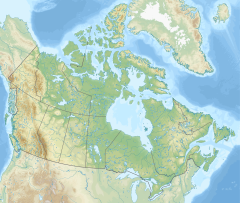| St. Lawrence River Estuary Estuaire du Saint-Laurent (in French) | |
|---|---|
 Maritime section at Port-au-Saumon | |
| Etymology | Saint Lawrence of Rome |
| Location | |
| Country | Canada |
| Province | Quebec |
| Physical characteristics | |
| Source | Saint Lawrence River |
| • location | Lake Saint-Pierre, Trois-Rivières |
| • coordinates | 46°16′17″N 72°38′5″W / 46.27139°N 72.63472°W |
| Mouth | Gulf of St. Lawrence / Atlantic Ocean |
• location | Pointe des Monts |
• coordinates | 49°19′N 67°23′W / 49.317°N 67.383°W |
• elevation | 0 m (0 ft) |
| Discharge | |
| • location | below the Saint Lawrence River |
St. Lawrence River Estuary stretches from west to east for 655 km, from the outlet of Lake Saint Pierre to Pointe-des-Monts,[1] where it becomes the Gulf of St. Lawrence, in Quebec, Canada.
The estuary is divided into 3 parts: the fluvial estuary, the middle estuary and the maritime estuary.[1][2] The waters coming from the north shore of the St. Lawrence and Labrador come mainly from the Canadian Shield.[3]
Among the deepest and largest estuaries in the world, the St. Lawrence maritime estuary extends nearly 250 km before it widens at Point-des-Monts into the Gulf of St. Lawrence. This enclosed sea is connected to the Atlantic Ocean by Cabot Strait and the Strait of Belle-Isle.
- ^ a b "Pointe des Monts". Toponymy Quebec Commission (in French). Government of Quebec. 1968-12-05. Retrieved 20 February 2024.
The coastline of Pointe des Monts on the North Shore and the city of Matane, opposite, in the Gaspé Peninsula, are the points that serve as the boundary between the estuary of the St. Lawrence River upstream, and the much wider Gulf of St. Lawrence, downstream.
- ^ "A river, estuaries, a gulf, the great hydrographic divisions" (PDF). Atlas of the St. Lawrence (in French). Atlas environnemental du Saint-Laurent. 1991. Retrieved 11 April 2024.
The width of the Lower Estuary varies from 24 km to Tadoussac 50 km to Pointe-des-Monts
- ^ Historica Canada (2024). "Great Lakes-St. Lawrence Watershed" (in English and French). Canadian Encyclopedia. Retrieved 18 April 2024.
The one million square kilometre region includes the Canadian portion of the watersheds of rivers that flow into the St. Lawrence River from east of Montreal, into the Gulf of St. Lawrence and into the Atlantic Ocean.

